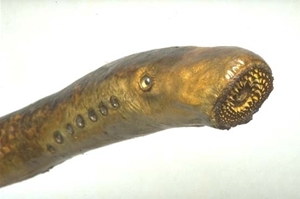Lampreys
 When you talk about lampreys, the first thing you need to realize is that these guys have been around for a long, long time! They were ancient even in 1135, when King Henry I reportedly died from eating - in the words of that famous phrase - "a surfeit of lampreys"! In fact, lampreys are the most primitive of all living vertebrates. Fossil discoveries suggest that they have lived from the late Silurian and Devonian periods, 450 million years ago.
When you talk about lampreys, the first thing you need to realize is that these guys have been around for a long, long time! They were ancient even in 1135, when King Henry I reportedly died from eating - in the words of that famous phrase - "a surfeit of lampreys"! In fact, lampreys are the most primitive of all living vertebrates. Fossil discoveries suggest that they have lived from the late Silurian and Devonian periods, 450 million years ago.
Lampreys are quite distinct from other fish in the British Isles. In fact they are not really fish at all. They have no lower jaw but instead the mouth is surrounded by a round, sucker-like disc that in adults, has a set of strong rasping teeth. Fish, on the other hand, have fixed upper jaws and hinged lower jaws. On first appearances lampreys resemble eels, but with a little further investigation you soon realise that the similarities end there. These ancient creatures have no bones at all, but instead the “skeleton” is made up of powerful and flexible cartilage and they only have one nostril which sits on top of the head, just behind the eyes. Seven holes that start behind the eye and run down each side of the body are gills, but they have no flap or operculum to act as a cover.
In Britain we have three species which are, in ascending size the brook, river and sea lamprey. The little brook lamprey only grows up to a maximum of 17cm in length, and is the most common and widespread of the three. The river lamprey is extremely similar in appearance to the brook lamprey, but can grow in some circumstances up to 40cm long. By far the largest of the three is the sea lamprey (pictured), which can grow to an enormous 100cm long and weigh in at 2.5kg.
The brook lamprey can be found all over the British Isles but its numbers have been declining. The larvae are rarely seen as they live hidden away in silt beds within streams and rivers (occasionally in lakes) and feed by filtering out fine organic particles. After about six years they turn into adults and produce a small set of teeth, even though they do not feed at all during this part of their life. During the autumn and winter they slowly travel upstream under the cover of darkness to find suitable shallow water spawning areas, consisting of small stones and gravel, similar to the areas used for spawning by trout. It is from March to early June that lamprey can most easily be spotted during daylight hours as spawning takes place. The females lay up to 1,500 eggs each (all adults die after spawning) and when the virtually blind larvae hatch, they drift off downstream to find suitable areas of silt into which they burrow, starting the process off all over again.
The river lamprey's life cycle is very similar to the brook lamprey However, having spent several years growing in silt beds, they change into small silvery adults and migrate downstream to the estuary where they grow to full maturity, feeding on fish such as herring and flounder. They quite often inflict serious damage on the backs of these fish by rasping away large amounts of flesh. During this time in salt water, river lamprey become quite “bloated” in appearance due to the gut becoming completely full of blood and flesh. After two years living in estuaries, River lamprey migrate back up the river to spawning grounds during the winter and spring, mating on the spawning grounds in March and April.
The sea lamprey's life cycle is similar to that of the river lamprey, but little is known about its time at sea, as it not only uses estuaries but also frequents much deeper waters, where it too feeds on fish. Many a rod-caught salmon or sea trout has the tale tell marks on its back caused by the rasping teeth of a sea lamprey.
Apart from the pollution of rivers and the silting up of important spawning grounds, all three lamprey (but especially the river and sea species) face the problem of physical barriers along a water ways, such as waterfalls, dams or weirs.
All three species of lamprey are now protected in Britain because their numbers have been declining. We need to learn more about these fascinating, ancient creatures, so that we can help to ensure that they continue to be part of the ecology of British waters, after all we have only just arrived here compared to them! The Game & Wildlife Conservation Trust has therefore recently teamed up with French scientists and started a new research programme called the MorFish project, to learn more about migratory fish, including lamprey.
Peter Thompson
Advisory
Read more from Peter Thompson at the Fresh from the Field blog.

Download Peter Thompson's essential 26-page book, featuring beautiful photography and detailed profiles of Britain's wildlife
Download FREE >